INTERNATIONAL
STANDARD
ISO/IEC
13818-1
Third edition
2007-10-15
Information technology — Generic coding
of moving pictures and associated audio
information: Systems
Technologies de l'information — Codage générique des images
animées et des informations sonores associées: Systèmes
Licensed to SUNRISE TELECOM/STEVE KIM
ISO Store order #:949258/Downloaded:2008-09-27
Single user licence only, copying and networking prohibited
Reference number
ISO/IEC 13818-1:2007(E)
© ISO/IEC 2007
�
ISO/IEC 13818-1:2007(E)
PDF disclaimer
This PDF file may contain embedded typefaces. In accordance with Adobe's licensing policy, this file may be printed or viewed but
shall not be edited unless the typefaces which are embedded are licensed to and installed on the computer performing the editing. In
downloading this file, parties accept therein the responsibility of not infringing Adobe's licensing policy. The ISO Central Secretariat
accepts no liability in this area.
Adobe is a trademark of Adobe Systems Incorporated.
Details of the software products used to create this PDF file can be found in the General Info relative to the file; the PDF-creation
parameters were optimized for printing. Every care has been taken to ensure that the file is suitable for use by ISO member bodies. In
the unlikely event that a problem relating to it is found, please inform the Central Secretariat at the address given below.
COPYRIGHT PROTECTED DOCUMENT
© ISO/IEC 2007
All rights reserved. Unless otherwise specified, no part of this publication may be reproduced or utilized in any form or by any means,
electronic or mechanical, including photocopying and microfilm, without permission in writing from either ISO at the address below or
ISO's member body in the country of the requester.
ISO copyright office
Case postale 56 • CH-1211 Geneva 20
Tel. + 41 22 749 01 11
Fax + 41 22 749 09 47
E-mail copyright@iso.org
Web www.iso.org
Published in Switzerland
ii
Licensed to SUNRISE TELECOM/STEVE KIM
ISO Store order #:949258/Downloaded:2008-09-27
Single user licence only, copying and networking prohibited
© ISO/IEC 2007 – All rights reserved
�
ISO/IEC 13818-1:2007(E)
CONTENTS
SECTION 1 – GENERAL ...................................................................................................................
1.1
Scope............................................................................................................................
1.2 Normative references.......................................................................................................
SECTION 2 – TECHNICAL ELEMENTS..............................................................................................
2.1 Definitions.....................................................................................................................
2.2
Symbols and abbreviations................................................................................................
2.3 Method of describing bit stream syntax ...............................................................................
Transport Stream bitstream requirements.............................................................................
2.4
Program Stream bitstream requirements ..............................................................................
2.5
2.6
Program and program element descriptors............................................................................
2.7 Restrictions on the multiplexed stream semantics ..................................................................
2.8 Compatibility with ISO/IEC 11172.....................................................................................
2.9 Registration of copyright identifiers....................................................................................
2.10 Registration of private data format......................................................................................
2.11 Carriage of ISO/IEC 14496 data.........................................................................................
2.12 Carriage of metadata........................................................................................................
2.13 Carriage of ISO 15938 data...............................................................................................
2.14 Carriage of ITU-T Rec. H.264 | ISO/IEC 14496-10 video .......................................................
Annex A – CRC decoder model ...........................................................................................................
A.0 CRC decoder model ........................................................................................................
Annex B – Digital Storage Medium Command and Control (DSM-CC)........................................................
B.0
Introduction ...................................................................................................................
B.1 General elements ............................................................................................................
B.2 Technical elements..........................................................................................................
Annex C – Program Specific Information ...............................................................................................
C.0 Explanation of Program Specific Information in Transport Streams ..........................................
Introduction ...................................................................................................................
C.1
C.2
Functional mechanism .....................................................................................................
C.3 The Mapping of Sections into Transport Stream Packets.........................................................
C.4 Repetition rates and random access.....................................................................................
C.5 What is a program?..........................................................................................................
C.6 Allocation of program_number ..........................................................................................
C.7 Usage of PSI in a typical system ........................................................................................
C.8 The relationships of PSI structures......................................................................................
C.9 Bandwidth utilization and signal acquisition time ..................................................................
D.0
F.0
Annex D – Systems timing model and application implications of this Recommendation | International
Standard.............................................................................................................................
Introduction ...................................................................................................................
Annex E – Data transmission applications...............................................................................................
E.0 General considerations.....................................................................................................
Suggestion.....................................................................................................................
E.1
Annex F – Graphics of syntax for this Recommendation | International Standard............................................
Introduction ...................................................................................................................
Annex G – General information............................................................................................................
G.0 General information.........................................................................................................
Annex H – Private data .......................................................................................................................
H.0 Private data....................................................................................................................
Annex I – Systems conformance and real-time interface ...........................................................................
Systems conformance and real-time interface .......................................................................
I.0
Licensed to SUNRISE TELECOM/STEVE KIM
ISO Store order #:949258/Downloaded:2008-09-27
Single user licence only, copying and networking prohibited
© ISO/IEC 2007 – All rights reserved
Page
1
1
1
2
2
6
7
8
51
63
94
98
98
99
99
111
120
120
124
124
125
125
126
128
133
133
133
134
135
135
135
136
136
137
139
141
141
149
149
150
151
151
156
156
157
157
158
158
iii
�
ISO/IEC 13818-1:2007(E)
Annex J – Interfacing jitter-inducing networks to MPEG-2 decoders............................................................
J.0
Introduction ...................................................................................................................
J.1 Network compliance models .............................................................................................
J.2 Network specification for jitter smoothing ...........................................................................
Example decoder implementations .....................................................................................
J.3
Annex K – Splicing Transport Streams...................................................................................................
Introduction ...................................................................................................................
K.0
K.1 The different types of splicing point....................................................................................
K.2 Decoder behaviour on splices ............................................................................................
Annex L – Registration procedure (see 2.9).............................................................................................
L.1
Procedure for the request of a Registered Identifier (RID) .......................................................
L.2 Responsibilities of the Registration Authority.......................................................................
L.3 Responsibilities of parties requesting an RID........................................................................
L.4 Appeal procedure for denied applications.............................................................................
Annex M – Registration application form (see 2.9)...................................................................................
M.1 Contact information of organization requesting a Registered Identifier (RID)..............................
M.2 Statement of an intention to apply the assigned RID...............................................................
M.3 Date of intended implementation of the RID.........................................................................
M.4 Authorized representative .................................................................................................
M.5 For official use only of the Registration Authority .................................................................
........................................................................................................................................
Annex N
Annex O – Registration procedure (see 2.10)...........................................................................................
O.1 Procedure for the request of an RID....................................................................................
O.2 Responsibilities of the Registration Authority.......................................................................
O.3 Contact information for the Registration Authority ................................................................
O.4 Responsibilities of parties requesting an RID........................................................................
O.5 Appeal procedure for denied applications.............................................................................
Annex P – Registration application form ................................................................................................
P.1 Contact information of organization requesting an RID ..........................................................
P.2 Request for a specific RID ................................................................................................
Short description of RID that is in use and date system that was implemented.............................
P.3
P.4
Statement of an intention to apply the assigned RID...............................................................
P.5 Date of intended implementation of the RID.........................................................................
P.6 Authorized representative .................................................................................................
P.7
For official use of the Registration Authority........................................................................
Annex Q – T-STD and P-STD buffer models for ISO/IEC 13818-7 ADTS....................................................
Q.1
Introduction ...................................................................................................................
Q.2 Leak rate from Transport Buffer.........................................................................................
Q.3 Buffer size.....................................................................................................................
Q.4 Conclusion.....................................................................................................................
Annex R – Carriage of ISO/IEC 14496 scenes in ITU-T Rec. H.222.0 | ISO/IEC 13818- .................................
R.1 Content access procedure for ISO/IEC 14496 program components within a Program Stream........
R.2 Content access procedure for ISO/IEC 14496 program components within a Transport
Stream ..........................................................................................................................
Page
158
158
159
159
160
161
161
162
162
164
164
164
164
165
165
165
165
165
165
166
166
167
167
167
167
167
167
168
168
168
168
168
168
168
168
169
169
169
169
171
172
172
173
iv
Licensed to SUNRISE TELECOM/STEVE KIM
ISO Store order #:949258/Downloaded:2008-09-27
Single user licence only, copying and networking prohibited
© ISO/IEC 2007 – All rights reserved
�
ISO/IEC 13818-1:2007(E)
Foreword
ISO (the International Organization for Standardization) and IEC (the International Electrotechnical
Commission) form the specialized system for worldwide standardization. National bodies that are members of
ISO or IEC participate in the development of International Standards through technical committees
established by the respective organization to deal with particular fields of technical activity. ISO and IEC
technical committees collaborate in fields of mutual interest. Other international organizations, governmental
and non-governmental, in liaison with ISO and IEC, also take part in the work. In the field of information
technology, ISO and IEC have established a joint technical committee, ISO/IEC JTC 1.
International Standards are drafted in accordance with the rules given in the ISO/IEC Directives, Part 2.
The main task of the joint technical committee is to prepare International Standards. Draft International
Standards adopted by the joint technical committee are circulated to national bodies for voting. Publication as
an International Standard requires approval by at least 75 % of the national bodies casting a vote.
Attention is drawn to the possibility that some of the elements of this document may be the subject of patent
rights. ISO and IEC shall not be held responsible for identifying any or all such patent rights.
ISO/IEC 13818-1 was prepared by Joint Technical Committee ISO/IEC JTC 1, Information technology,
Subcommittee SC 29, Coding of audio, picture, multimedia and hypermedia information, in collaboration with
ITU-T. The identical text is published as ITU-T Rec. H.222.0 (05/2006).
revised.
It also
This third edition cancels and replaces the second edition (ISO/IEC 13818-1:2000), which has been
technically
ISO/IEC 13818-1:2000/Amd.1:2003,
ISO/IEC 13818-1:2000/Amd.2:2004, ISO/IEC 13818-1:2000/Amd.3:2004, ISO/IEC 13818-1:2000/Amd.4:2005
and ISO/IEC 13818-1:2000/Amd.5:2005, and the Technical Corrigenda ISO/IEC 13818-1:2000/Cor.1:2002,
ISO/IEC 13818-1:2000/Cor.2:2002, ISO/IEC 13818-1:2000/Cor.3:2005, ISO/IEC 13818-1:2000/Cor.4:2007.
the Amendments
incorporates
ISO/IEC 13818 consists of the following parts, under the general title Information technology — Generic
coding of moving pictures and associated audio information:
⎯ Part 1: Systems
⎯ Part 2: Video
⎯ Part 3: Audio
⎯ Part 4: Conformance testing
⎯ Part 5: Software simulation [Technical Report]
⎯ Part 6: Extensions for DSM-CC
⎯ Part 7: Advanced Audio Coding (AAC)
⎯ Part 9: Extension for real time interface for systems decoders
⎯ Part 10: Conformance extensions for Digital Storage Media Command and Control (DSM-CC)
⎯ Part 11: IPMP on MPEG-2 systems
Licensed to SUNRISE TELECOM/STEVE KIM
ISO Store order #:949258/Downloaded:2008-09-27
Single user licence only, copying and networking prohibited
© ISO/IEC 2007 – All rights reserved
v
�
ISO/IEC 13818-1:2007(E)
Introduction
The systems part of this Recommendation | International Standard addresses the combining of one or more elementary
streams of video and audio, as well as other data, into single or multiple streams which are suitable for storage or
transmission. Systems coding follows the syntactical and semantic rules imposed by this Specification and provides
information to enable synchronized decoding of decoder buffers over a wide range of retrieval or receipt conditions.
System coding shall be specified in two forms: the Transport Stream and the Program Stream. Each is optimized for
a different set of applications. Both the Transport Stream and Program Stream defined in this Recommendation |
International Standard provide coding syntax which is necessary and sufficient to synchronize the decoding and
presentation of the video and audio information, while ensuring that data buffers in the decoders do not overflow or
underflow. Information is coded in the syntax using time stamps concerning the decoding and presentation of coded
audio and visual data and time stamps concerning the delivery of the data stream itself. Both stream definitions are
packet-oriented multiplexes.
The basic multiplexing approach for single video and audio elementary streams is illustrated in Figure Intro. 1. The
video and audio data is encoded as described in ITU-T Rec. H.262 | ISO/IEC 13818-2 and ISO/IEC 13818-3. The
resulting compressed elementary streams are packetized to produce PES packets. Information needed to use PES
packets independently of either Transport Streams or Program Streams may be added when PES packets are formed.
This information is not needed and need not be added when PES packets are further combined with system level
information to form Transport Streams or Program Streams. This systems standard covers those processes to the
right of the vertical dashed line.
Video
data
Audio
data
Video
encoder
Audio
encoder
Packetizer
Video PES
Packetizer
Audio PES
PS
mux
TS
mux
Program
Stream
Transport
Stream
Extent of systems specification
TISO5760-95/d01
Figure Intro. 1 – Simplified overview of the scope of this Recommendation | International Standard
The Program Stream is analogous and similar to ISO/IEC 11172 Systems layer. It results from combining one or more
streams of PES packets, which have a common time base, into a single stream.
For applications that require the elementary streams which comprise a single program to be in separate streams which
are not multiplexed, the elementary streams can also be encoded as separate Program Streams, one per elementary
stream, with a common time base. In this case the values encoded in the SCR fields of the various streams shall be
consistent.
Like the single Program Stream, all elementary streams can be decoded with synchronization.
The Program Stream is designed for use in relatively error-free environments and is suitable for applications which may
involve software processing of system information such as interactive multi-media applications. Program Stream
packets may be of variable and relatively great length.
The Transport Stream combines one or more programs with one or more independent time bases into a single stream.
PES packets made up of elementary streams that form a program share a common timebase. The Transport Stream is
designed for use in environments where errors are likely, such as storage or transmission in lossy or noisy media.
Transport Stream packets are 188 bytes in length.
Licensed to SUNRISE TELECOM/STEVE KIM
ISO Store order #:949258/Downloaded:2008-09-27
Single user licence only, copying and networking prohibited
vi
© ISO/IEC 2007 – All rights reserved
�
ISO/IEC 13818-1:2007(E)
Program and Transport Streams are designed for different applications and their definitions do not strictly follow a
layered model. It is possible and reasonable to convert from one to the other; however, one is not a subset or superset of
the other. In particular, extracting the contents of a program from a Transport Stream and creating a valid Program
Stream is possible and is accomplished through the common interchange format of PES packets, but not all of the fields
needed in a Program Stream are contained within the Transport Stream; some must be derived. The Transport Stream
may be used to span a range of layers in a layered model, and is designed for efficiency and ease of implementation in
high bandwidth applications.
The scope of syntactical and semantic rules set forth in the systems specification differ: the syntactical rules apply to
systems layer coding only, and do not extend to the compression layer coding of the video and audio specifications; by
contrast, the semantic rules apply to the combined stream in its entirety.
The systems specification does not specify the architecture or implementation of encoders or decoders, nor those of
multiplexors or demultiplexors. However, bit stream properties do impose functional and performance requirements on
encoders, decoders, multiplexors and demultiplexors. For instance, encoders must meet minimum clock tolerance
requirements. Notwithstanding this and other requirements, a considerable degree of freedom exists in the design and
implementation of encoders, decoders, multiplexors, and demultiplexors.
Intro. 1 Transport Stream
The Transport Stream is a stream definition which is tailored for communicating or storing one or more programs of
coded data according to ITU-T Rec. H.262 | ISO/IEC 13818-2 and ISO/IEC 13818-3 and other data in environments in
which significant errors may occur. Such errors may be manifested as bit value errors or loss of packets.
Transport Streams may be either fixed or variable rate. In either case the constituent elementary streams may either be
fixed or variable rate. The syntax and semantic constraints on the stream are identical in each of these cases. The
Transport Stream rate is defined by the values and locations of Program Clock Reference (PCR) fields, which in general
are separate PCR fields for each program.
There are some difficulties with constructing and delivering a Transport Stream containing multiple programs with
independent time bases such that the overall bit rate is variable. Refer to 2.4.2.2.
The Transport Stream may be constructed by any method that results in a valid stream. It is possible to construct
Transport Streams containing one or more programs from elementary coded data streams, from Program Streams, or
from other Transport Streams which may themselves contain one or more programs.
The Transport Stream is designed in such a way that several operations on a Transport Stream are possible with
minimum effort. Among these are:
1) Retrieve the coded data from one program within the Transport Stream, decode it and present the
decoded results as shown in Figure Intro. 2.
2) Extract the Transport Stream packets from one program within the Transport Stream and produce as
output a different Transport Stream with only that one program as shown in Figure Intro. 3.
3) Extract the Transport Stream packets of one or more programs from one or more Transport Streams and
produce as output a different Transport Stream (not illustrated).
4) Extract the contents of one program from the Transport Stream and produce as output a Program Stream
containing that one program as shown in Figure Intro. 4.
5) Take a Program Stream, convert it into a Transport Stream to carry it over a lossy environment, and then
recover a valid, and in certain cases, identical Program Stream.
Figure Intro. 2 and Figure Intro. 3 illustrate prototypical demultiplexing and decoding systems which take as input a
Transport Stream. Figure Intro. 2 illustrates the first case, where a Transport Stream is directly demultiplexed and
decoded. Transport Streams are constructed in two layers:
–
–
a system layer; and
a compression layer.
The input stream to the Transport Stream decoder has a system layer wrapped about a compression layer. Input streams
to the Video and Audio decoders have only the compression layer.
Operations performed by the prototypical decoder which accepts Transport Streams either apply to the entire Transport
Stream ("multiplex-wide operations"), or to individual elementary streams ("stream-specific operations"). The
Transport Stream system layer is divided into two sub-layers, one for multiplex-wide operations (the Transport Stream
packet layer), and one for stream-specific operations (the PES packet layer).
A prototypical decoder for Transport Streams, including audio and video, is also depicted in Figure Intro. 2 to illustrate
the function of a decoder. The architecture is not unique – some system decoder functions, such as decoder timing
Licensed to SUNRISE TELECOM/STEVE KIM
ISO Store order #:949258/Downloaded:2008-09-27
Single user licence only, copying and networking prohibited
© ISO/IEC 2007 – All rights reserved
vii
�
ISO/IEC 13818-1:2007(E)
control, might equally well be distributed among elementary stream decoders and the channel-specific decoder – but
this figure is useful for discussion. Likewise, indication of errors detected by the channel-specific decoder to the
individual audio and video decoders may be performed in various ways and such communication paths are not shown in
the diagram. The prototypical decoder design does not imply any normative requirement for the design of a Transport
Stream decoder. Indeed non-audio/video data is also allowed, but not shown.
Video
decoder
Decoded
video
Channel
Channel specific
decoder
Transport Stream
demultiplex
and decoder
Clock
control
Transport Stream
containing one or multiple programs
Audio
decoder
Decoded
audio
Figure Intro. 2 – Prototypical transport demultiplexing and decoding example
TISO5770-95/d02
Figure Intro. 3 illustrates the second case, where a Transport Stream containing multiple programs is converted into a
Transport Stream containing a single program. In this case the re-multiplexing operation may necessitate the correction
of Program Clock Reference (PCR) values to account for changes in the PCR locations in the bit stream.
Channel
Channel specific
decoder
Transport Stream
demultiplex
and decoder
Transport Stream
containing multiple programs
TISO5780-95/d03
Transport Stream
with single program
Figure Intro. 3 – Prototypical transport multiplexing example
Figure Intro. 4 illustrates a case in which a multi-program Transport Stream is first demultiplexed and then converted
into a Program Stream.
Figures Intro. 3 and Intro. 4 indicate that it is possible and reasonable to convert between different types and
configurations of Transport Streams. There are specific fields defined in the Transport Stream and Program Stream
syntax which facilitate the conversions illustrated. There is no requirement that specific implementations of
demultiplexors or decoders include all of these functions.
Channel
Channel specific
decoder
Transport Stream
demultiplex and
Program Stream
multiplexor
Transport Stream
containing multiple programs
TISO5790-95/d04
Program Stream
Figure Intro. 4 – Prototypical Transport Stream to Program Stream conversion
Intro. 2 Program Stream
The Program Stream is a stream definition which is tailored for communicating or storing one program of coded data
and other data in environments where errors are very unlikely, and where processing of system coding, e.g., by
software, is a major consideration.
Licensed to SUNRISE TELECOM/STEVE KIM
ISO Store order #:949258/Downloaded:2008-09-27
Single user licence only, copying and networking prohibited
viii
© ISO/IEC 2007 – All rights reserved
�
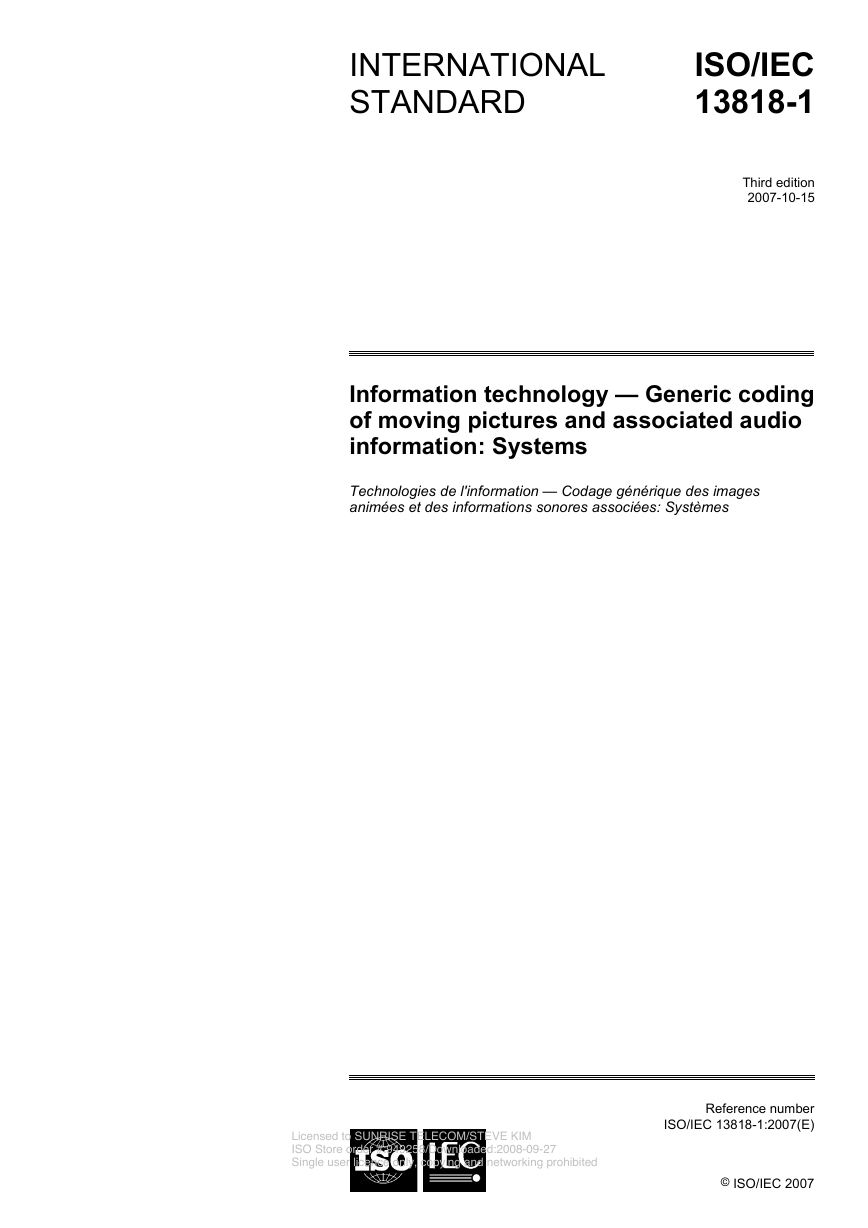
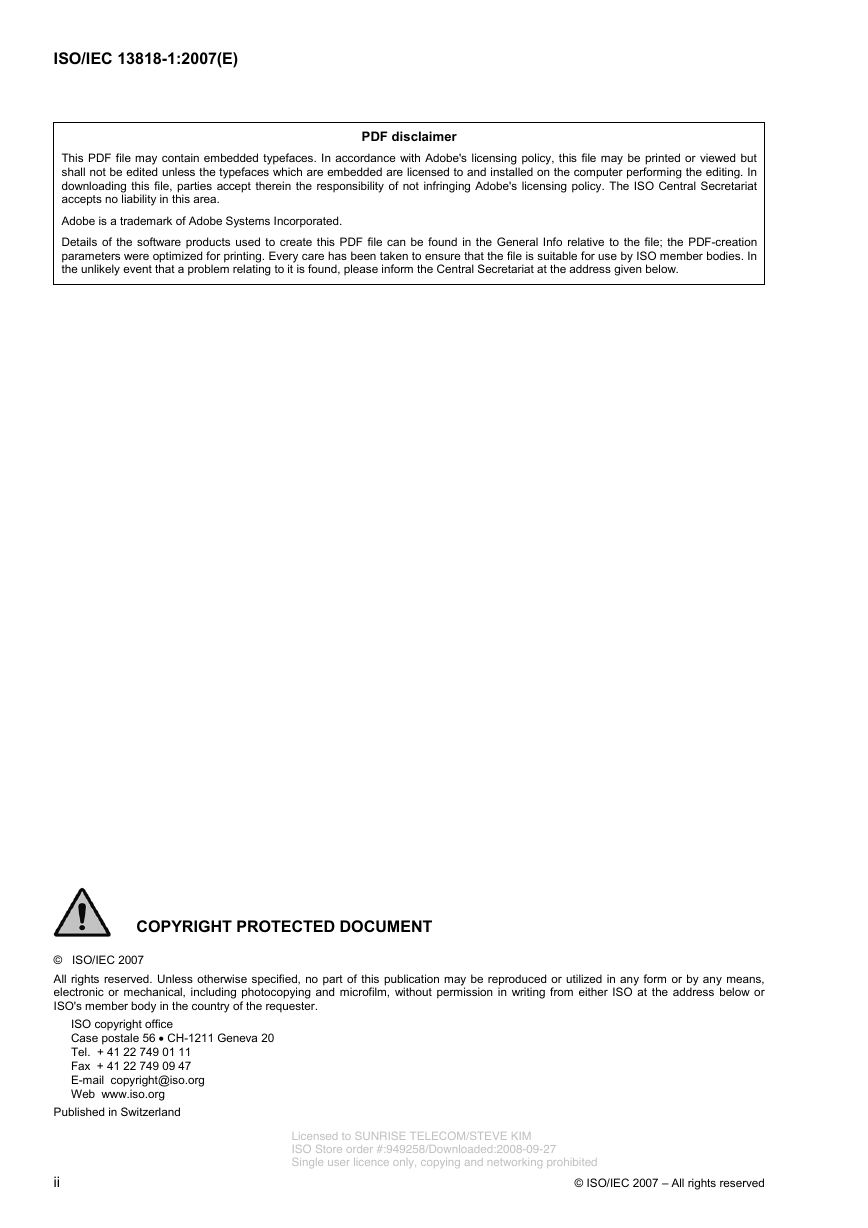
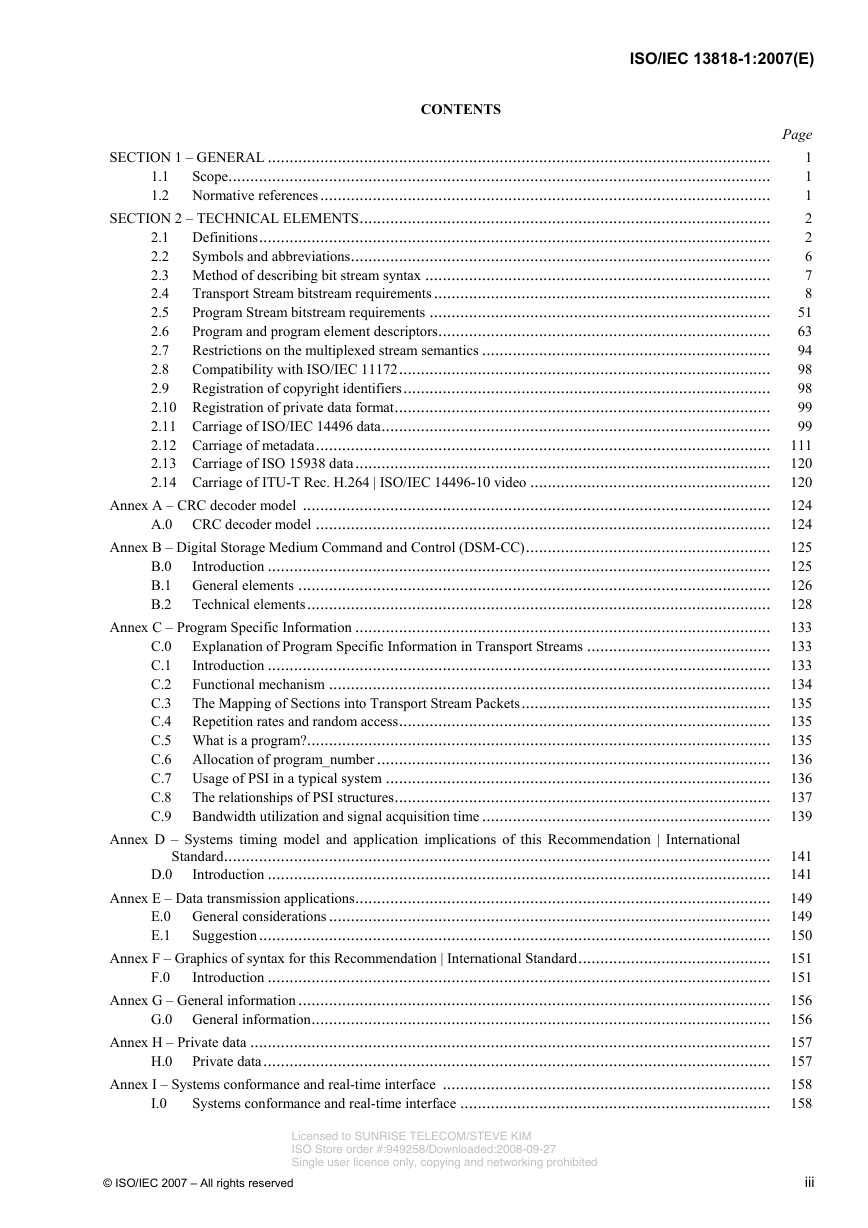

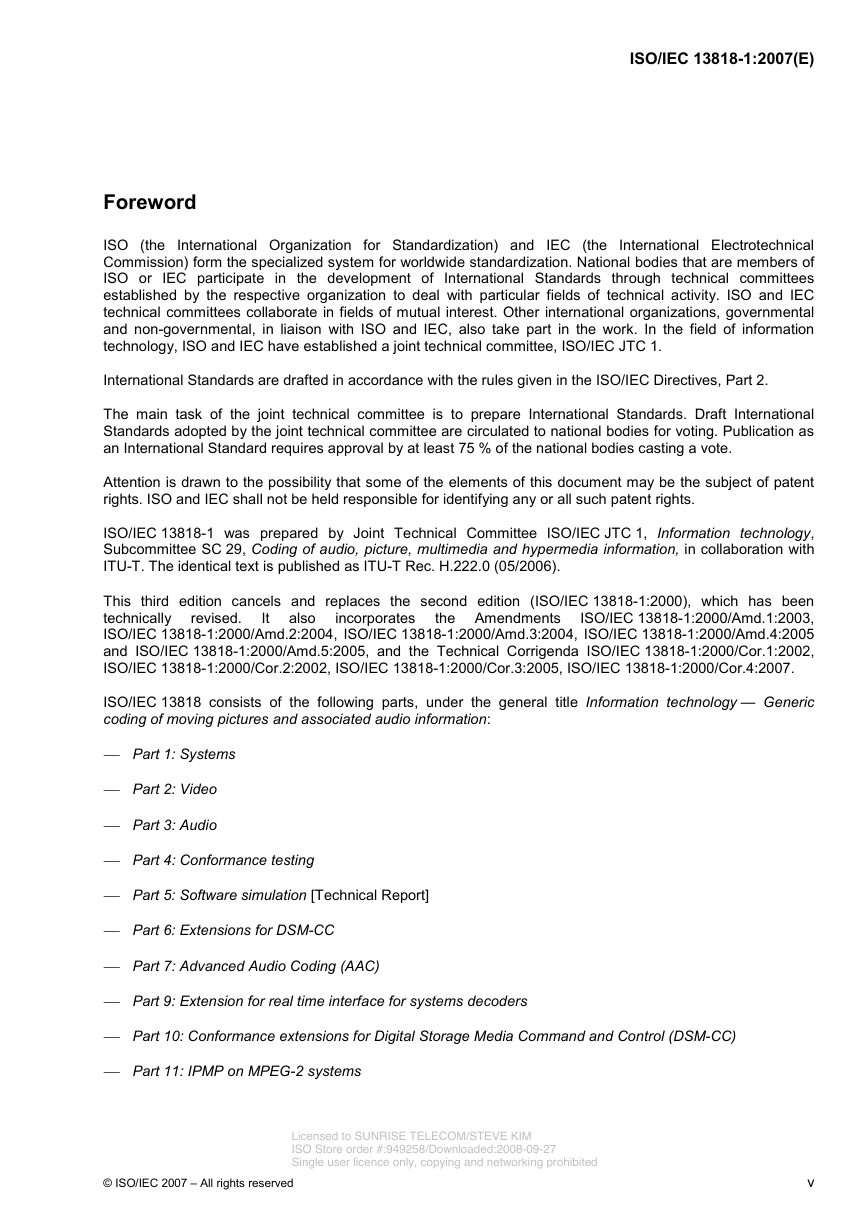
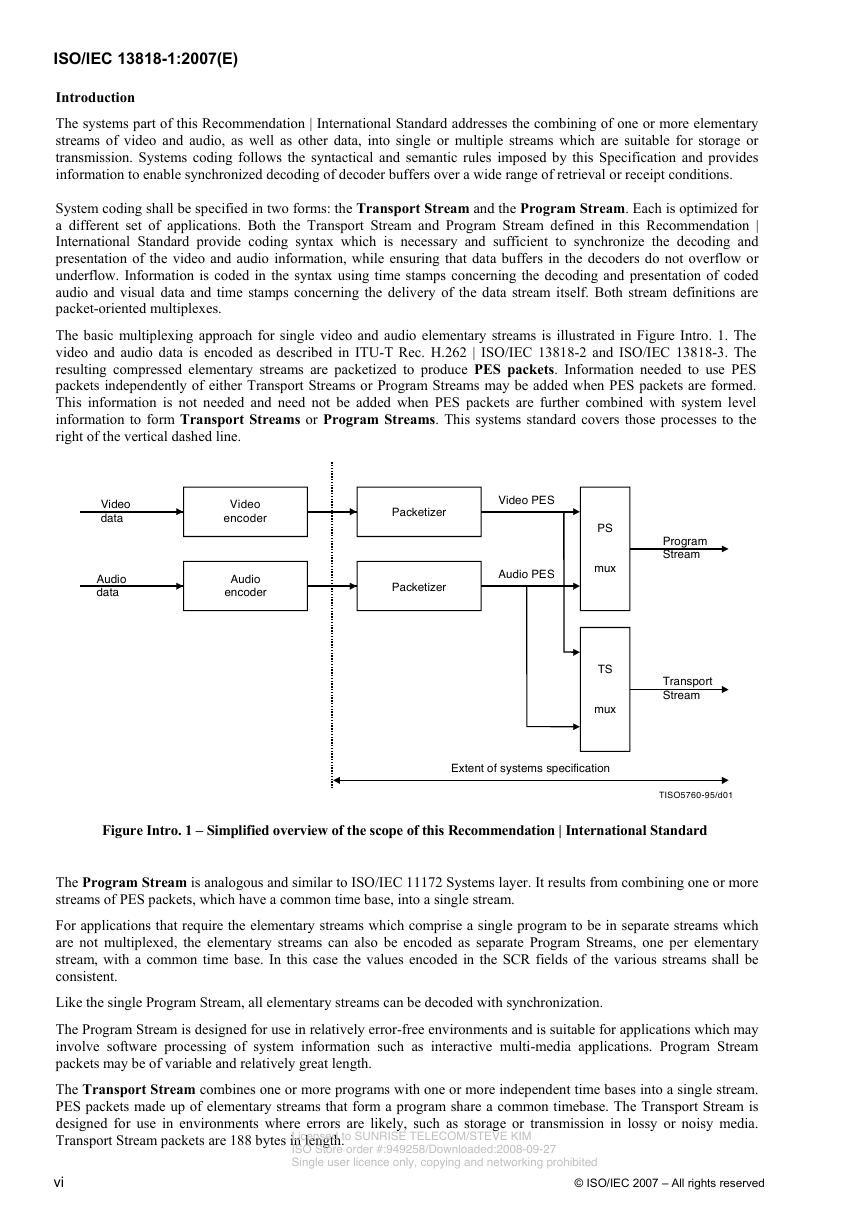
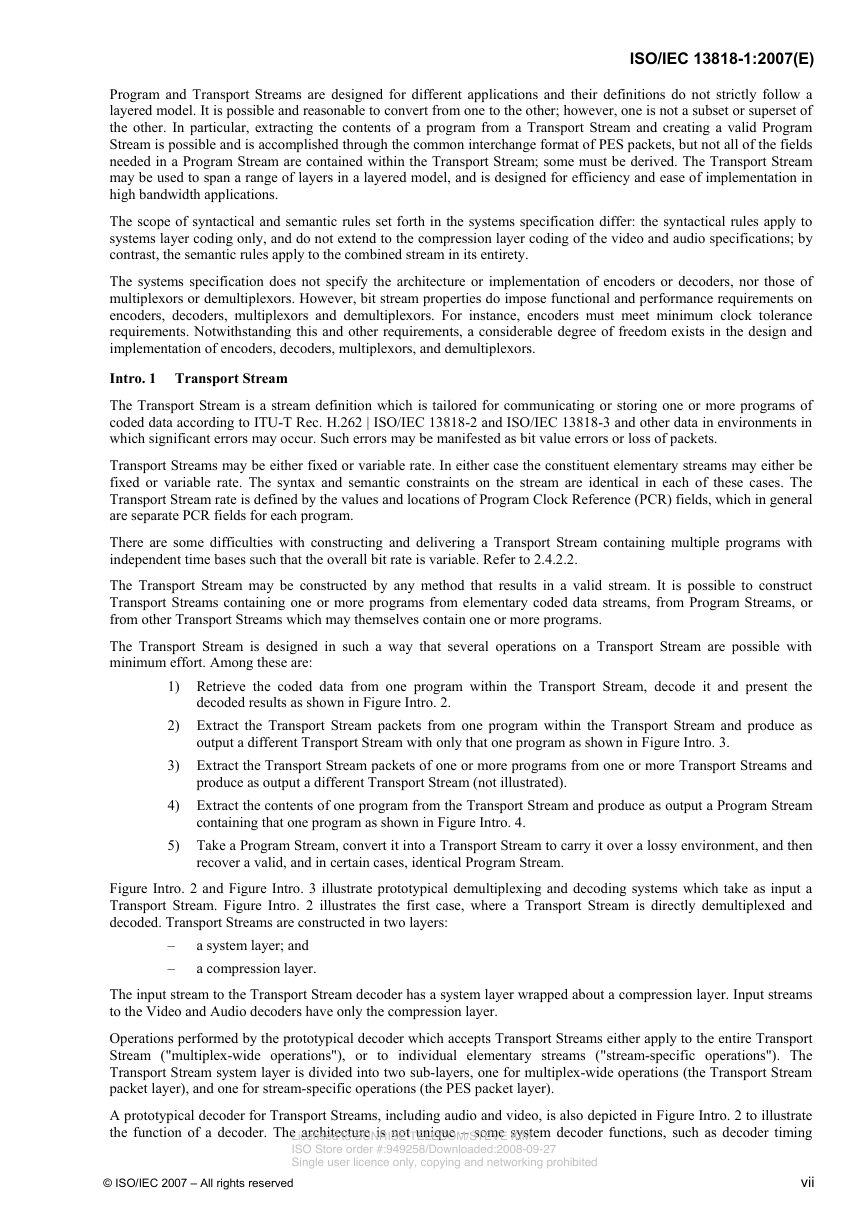
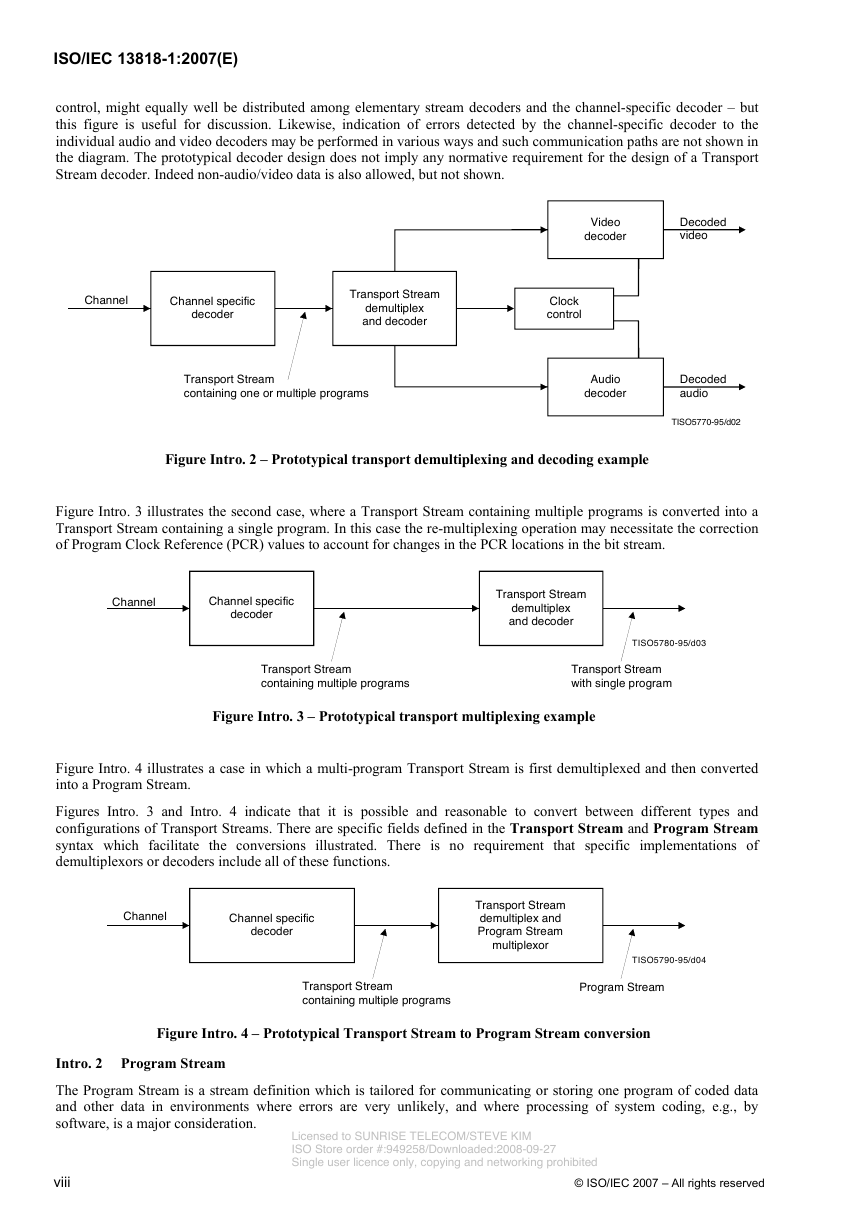








 2023年江西萍乡中考道德与法治真题及答案.doc
2023年江西萍乡中考道德与法治真题及答案.doc 2012年重庆南川中考生物真题及答案.doc
2012年重庆南川中考生物真题及答案.doc 2013年江西师范大学地理学综合及文艺理论基础考研真题.doc
2013年江西师范大学地理学综合及文艺理论基础考研真题.doc 2020年四川甘孜小升初语文真题及答案I卷.doc
2020年四川甘孜小升初语文真题及答案I卷.doc 2020年注册岩土工程师专业基础考试真题及答案.doc
2020年注册岩土工程师专业基础考试真题及答案.doc 2023-2024学年福建省厦门市九年级上学期数学月考试题及答案.doc
2023-2024学年福建省厦门市九年级上学期数学月考试题及答案.doc 2021-2022学年辽宁省沈阳市大东区九年级上学期语文期末试题及答案.doc
2021-2022学年辽宁省沈阳市大东区九年级上学期语文期末试题及答案.doc 2022-2023学年北京东城区初三第一学期物理期末试卷及答案.doc
2022-2023学年北京东城区初三第一学期物理期末试卷及答案.doc 2018上半年江西教师资格初中地理学科知识与教学能力真题及答案.doc
2018上半年江西教师资格初中地理学科知识与教学能力真题及答案.doc 2012年河北国家公务员申论考试真题及答案-省级.doc
2012年河北国家公务员申论考试真题及答案-省级.doc 2020-2021学年江苏省扬州市江都区邵樊片九年级上学期数学第一次质量检测试题及答案.doc
2020-2021学年江苏省扬州市江都区邵樊片九年级上学期数学第一次质量检测试题及答案.doc 2022下半年黑龙江教师资格证中学综合素质真题及答案.doc
2022下半年黑龙江教师资格证中学综合素质真题及答案.doc